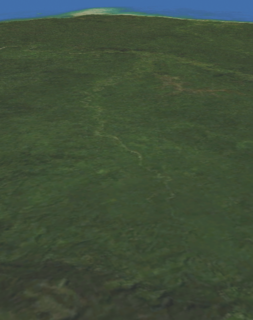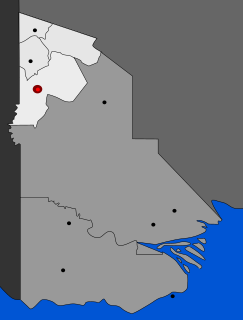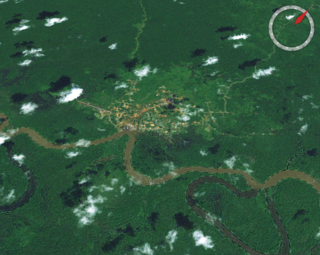The Wopkaimin are a small aboriginal tribe that lives in the remote Star Mountains in western Papua New Guinea in what is known as the Fly River socio-ecological region. The tribe speaks Faiwol. The Ok Tedi Mine, the third largest open pit copper and gold mine in the world is located in their traditional territory. Before the coming of the mine with construction starting in 1981 the Wopkaimin lived in a subsistence economy. The mine severely impacted the tribe, totally disrupting their traditional patterns of life. For one thing, Tabubil a town of 12,500 to house mine workers was built in the midst of their territory. Work for wages was available to tribal members, but only at the unskilled level and not on a regular basis. The Wopkaimin along with many other ethnic groups living in the area now live on a rotating basis between the town of Tabubil, roadside villages along the Kiunga-Tabubil Highway, and in villages away from the mine as jobs are lost or become available.

The Fly, at 1,050 kilometres (650 mi), is the second longest river in Papua New Guinea, after the Sepik. By volume of discharge, the Fly is the largest river in Oceania, the largest in the world without a single dam in its catchment, and overall the 25th-largest primary river in the world. It rises in the Victor Emanuel Range arm of the Star Mountains, and crosses the south-western lowlands before flowing into the Gulf of Papua in a large delta.

The Strickland River is a river in the Western Province of Papua New Guinea, and is the largest tributary of the Fly River. It was named after Edward Strickland, vice-president of the Geographical Society of Australasia by the New Guinea Exploration Expedition of 1885.

The Ok Tedi is a river in New Guinea. The Ok Tedi Mine is located near the headwaters of the river, which is sourced in the Star Mountains. Nearly the entirety of the river runs through the North Fly District of the Western Province of Papua New Guinea, but the river crosses the international boundary with Indonesia for less than one kilometre. The largest settlement of the Western Province, Tabubil is located near its banks.

Mount Hagen is the third largest city in Papua New Guinea, with a population of 46,250. It is the capital of the Western Highlands Province and is located in the large fertile Wahgi Valley in central mainland Papua New Guinea, at an elevation of 1,677 m (5,502 ft).

Tabubil is a town, company operated township located in the Star Mountains area of the North Fly District of Western Province, Papua New Guinea. The town, including the adjoining relocated village of Wangabin and the industrial area of Laydown, is the largest settlement in the province, although the provincial capital, Daru is a similar size. It had a recorded population of 10,270 at the 2011 census.

The Ok Tedi Mine is an open-pit copper and gold mine in Papua New Guinea located near the headwaters of the Ok Tedi River, in the Star Mountains Rural LLG of the North Fly District of the Western Province of Papua New Guinea. Discharges from the mine have caused widespread and diverse harm, both environmentally and socially, to the 50,000 people who live in the 120 villages downstream of the mine.

Ok Tedi Mining Limited is a Papua New Guinean company that administers the Ok Tedi Mine in the northern part of the Western Province. Its main office is located in Tabubil and the building is known as the White House. Its chairman, since 2014, has been former Deputy Prime Minister Moi Avei.

The Ok Tedi environmental disaster caused severe harm to the environment along 1,000 kilometres (620 mi) of the Ok Tedi River and the Fly River in the Western Province of Papua New Guinea between about 1984 and 2013. The lives of 50,000 people have been disrupted. One of the worst environmental disasters caused by humans, it is a consequence of the discharge of about two billion tons of untreated mining waste into the Ok Tedi from the Ok Tedi Mine, an open pit mine in the Western Province of Papua New Guinea.

The Kiunga-Tabubil Highway is an all-weather gravel road that runs from the river port town of Kiunga through Ningerum and Tabubil to the Ok Tedi Mine site, in the remote North Fly District of the Western Province of Papua New Guinea. The road is around 137 kilometres (85 mi) long, but this changes as sections are rehashed.

Kiunga Urban LLG is a local-level government area situated in North Fly District of Western Province of Papua New Guinea. In the year 2000, the LLG had a population of 8265 people. The township of Kiunga, which is governed by this LLG is the government seat of the district.

The Middle Fly District of the Western Province of Papua New Guinea is a large, coastal district that forms the central area of the Fly River basin. It contains the Local-Level Government areas of: Balimo Urban, Bamu Rural, Gogodaia Rural, Lake Murray Rural, and Nomad Rural, and the population centres of Balimo, Bamu, Gogodala and Nomad. It also contains the largest lake in the country, Lake Murray.
The glass blue-eye is a species of fish in the subfamily Pseudomugilinae. It is endemic to Papua New Guinea where it is only known to occur in a few small creeks adjacent to a 15–20 kilometres (9.3–12.4 mi) stretch of the Ok Tedi Mine supply road between the settlements of Kiunga and Tabubil in the Upper Fly River system close to the frontier with Irian Jaya. This species has a mainly transparent body with silvery gill covers and belly, there are black spots on the margins of the scales and there are black markings on the fins and lateral line, with the fins being shaded with yellow, with the exception of the transparent pectoral fins. It attains a standard length of 3 centimetres (1.2 in).This species was described by Gerald R. Allen in 1983 and its specific name honours the site biologist at the Ok Tedi Mine, David Balloch, for the support and assistance he gave Allen.
The Birim River or Ok Birim in the western province of New Guinea is a tributary of the Ok Tedi River, which is in turn a tributary of the north Fly River. The Birim river joins the Ok Tedi river from the west between Ningerum and Bige. The Birim river area is inhabited by the Yonggom tribe. They practise tropical forest Swidden agriculture. About 3,000 people, they speak the Ninggerum language of the Ok group.



















